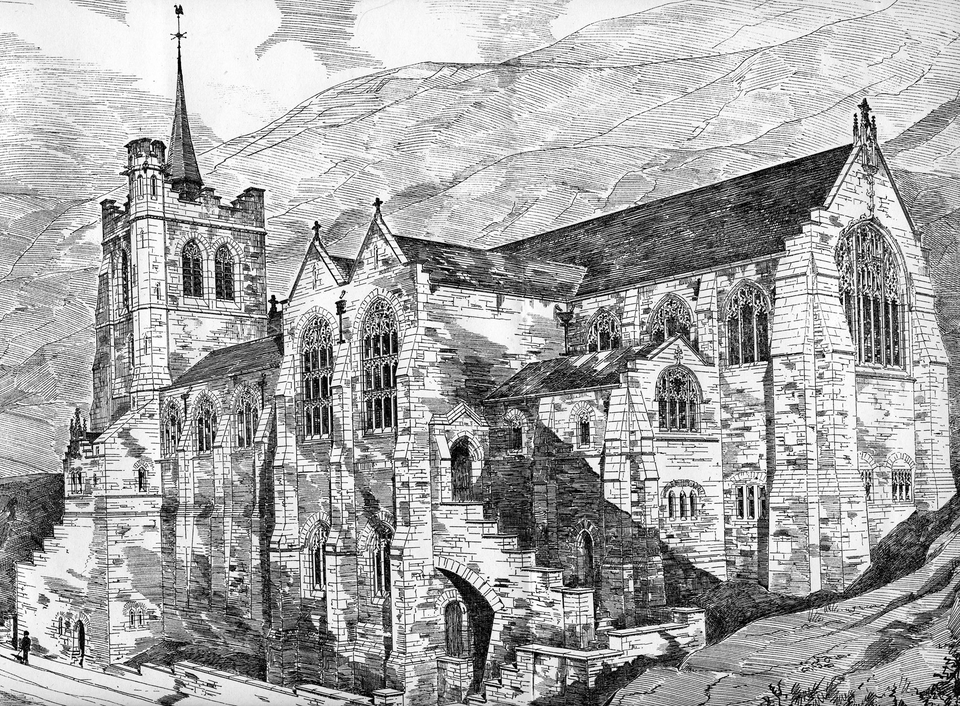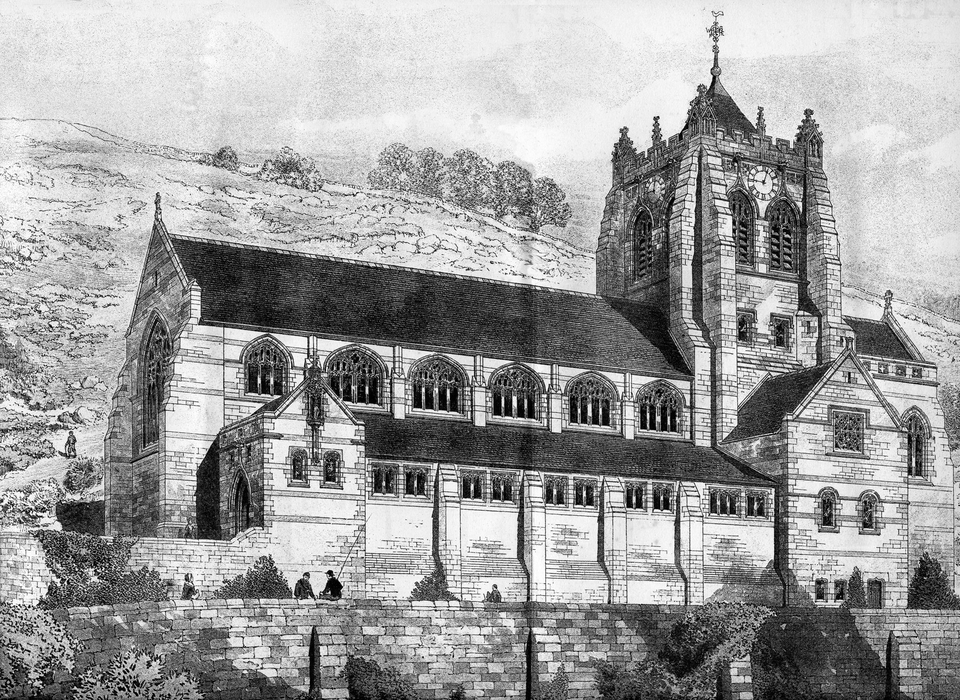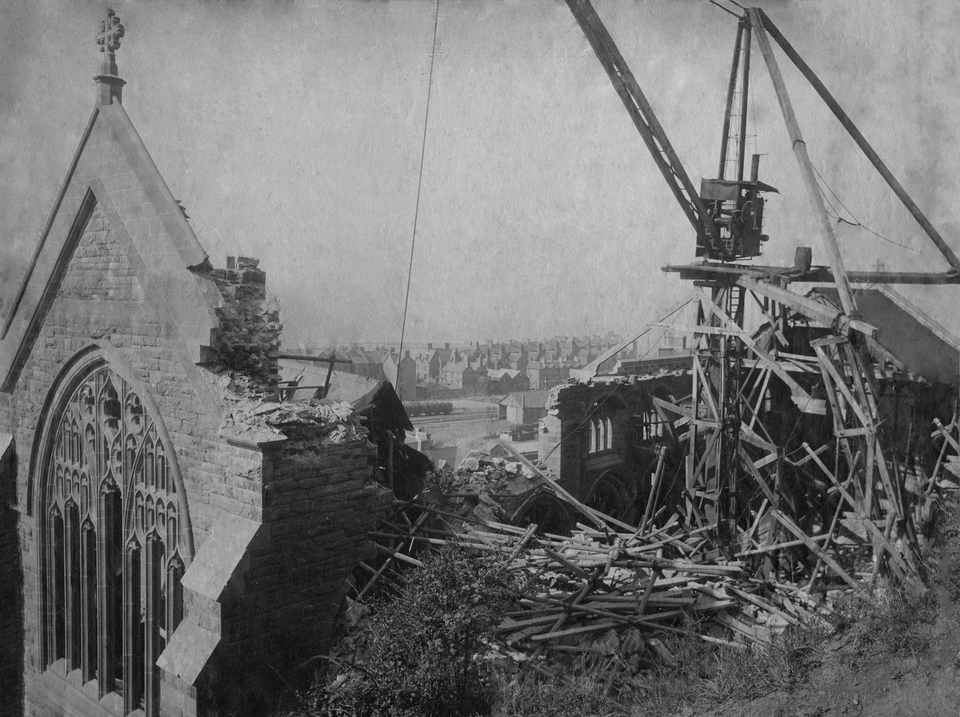Sefydlu Eglwys St Ioan
Mae'r gwybodaeth canlynol yn seiliedig ar y Dathliadau Canmlwyddiant daflen a ysgrifennwyd gan y Parch Geoff Holden a gyhoeddwyd yn 1989.
Gweithiodd ewyllys greadigol Duw drwy lawer o bobl i ganfod Eglwys Sant Ioan yr Efengylor i gael ei hadeiladu. Dyma'r stori honno.
Mae'r stori'n dechrau gyda dyfodiad y Parchedig Edward Hughes, pan gafodd ei gynnig fywoliaeth Llanaber gyda Abermaw yn ystod y flwyddyn 1887. Mae'i benodiad yn gael ei weld yn un dda fel ei fod yn cynnal ei weinidogaeth, gyda'r ei wraig hynaws, gydag ynni a chydwybod gymdeithasol fywiog.

Daeth o hyd cyflwr isel iawn o bywyd addoli yn y Plwyf oedd wedi cael i achosi gan nifer o broblemau. Roedd newid cymdeithasol sylweddol yn digwydd. Roedd pobl y dref fechan, ond yn ddiddorol iawn yn dod yn llai dibynnol ar y diwydiant pysgota lleol ac roedd mwy a mwy yn cymeryd rhan mewn gofalu am ymwelwyr ar eu gwyliau.
Gall pob un ohonom gresynu pasio adeilad cychod balch a hanes morwrol, ond gall dim newid harddwch naturiol mwyaf rhyfeddol o aber yr afon Mawddach a'r cefndir godidog o gadwyn fynyddoedd Cadair Idris. Roedd yr harddwch naturiol hwn a'r pleser newydd o wyliau glan môr denoedd cymaint o deuluoedd mawr i Abermaw.
Roedd cyn Rheithor Llanaber, y Parchedig John Jones MA eisoes wedi ceisio wella'r sefyllfa o seddi yn Eglwys Dewi Sant (Capel Anwes gan y cei) yr unig adeilad Anglicanaidd ar gyfer addoli yn Abermaw ei hun. Ond roedd y Capel Anwes yn profi'n hollol annigonol i ymdopi â'r nifer fawr o bobl oedd yn bresennol ar gyfer addoli.
Cynyddoedd y nifer o wasanaethau, Saesneg ac yna Gymraeg, ond doedd y pragmatiaeth hwn ddim yn cwrdd â'r angen yr amser. Cafodd y Rheithor mwy o cymorth gan glerigwyr, ond wnaeth dim o'r mesurau hyn help llawer i ddatrys y broblem o niferoedd fawr yn dod i addoli.
O ganlyniad, cafodd y penderfyniad o adeiladu eglwys Anglicanaidd mawr newydd yn Abermaw ei cymeryd.
Felly, ar ôl gwneud ei benderfyniad rhanodd y Rheithor ei feddyliau gyda'i Wardeniaid a Chyngor Plwyf Eglwysig ar unwaith. Roeddent yn hollol o blaid ac derchrodd y gwaith o brynu safle ar unwaith. Oherwydd safle daearyddol mae dir wastad wedi bod ar bremiwm yn Abermaw, ond cafodd cynnig o silff o graig i'r gogledd o'r dref ei dderbyn. Roedd amheuwyr yn feirniadol ac yn tynnu sylw at yr anawsterau amlwg o ffrwydro'r graig i greu teras ac fod mynediad i'r safle ddim yn mynd i bod yn hawdd. Parhaoedd y pwyllgorau Codi Adeilad yr Eglwys a Codi arian i gario mlaen yn eu tasg. Wnaeth cystadleuaeth i ddylunio'r eglwys cael ei cyhoeddi gan cylchgrawn "The Builder" yn ystod Mehefin a Gorffennaf 1889.

Y Rheithor, yn gyfrifol yn bersonol am gymaint o'r prosiect, yn aml yn isel gan ddiffyg cefnogaeth ariannol a llawer o addewidion wedi i torri. Ond roedd Canon Hughes yn ddyn o ansawdd cryf, dewrder mawr a ffydd mewnol. Roedd ei dyfalbarhad yn cael ei gwobrwyo mewn modd na allai fod wedi breuddwydio hyd yn oed yn ei eiliadau o optimistiaeth mwyaf.
Byw yn ei chartref gwyliau, Plas Mynach (Abermaw), roedd ddynes o gyfoeth ac o gydymdeimlad mawr i'r eglwys ac i'r rhai a oedd yn gweithio ar gyfer ei barhad yn y dref. Roedd Mrs Sarah Perrins falch iawn bod ei chymorth wedi'i geisio.

Yn gyflym iawn gwelodd y cyfle i gynnig cofeb i'w diweddar ŵr James Dyson Perrins. Roedd hi'n mwyaf hael ac yn cynnig y swm o £ 15,000 fel cyfran goffa yn yr adeilad yr eglwys newydd. Roedd Canon Hughes wedyn yn gwybod bod ei ddymuniad personol i adeiladu lle teilwng o addoliad ar gyfer Abermaw yn ddiogel. Cafodd cyfran y Plwyf £3,500 hefyd ei cytuno ac roedd wir gorfoledd mawr yng nghalonnau dynion eglwysig a menywod y diwrnod hwnnw.
Dydd Mawrth, 27 ain Awst 1889 daeth undod anarferol i dref Abermaw. Dim rhwystr gan unrhyw garfan o'r cyhoedd wedi ei godi i wneud y diwrnod o'r blaen na diwrnod o gorfoledd mawr. Dim tuedd wleidyddol neu enwadol oedd i'w gael. Mae'r Ysbryd Glân Duw wedi wir fuddugol. Mae presenoldeb a ragwelir ar Ei Huchelder Brenhinol y Dywysoges Beatrice a'i gŵr Tywysog Harri, hyd yn oed wedi taw ar y rhai fyddai fel arfer yn fwyaf lleisiol yn erbyn teulu brenhinol.
Cafodd gwahoddiad i Frenhines Fictoria eu gwneud yn gyntaf gan y Dowager Ardalyddes Londonderry. Drwy hap a damwain oedd y Frenhines ar wyliau yn Gogledd Cymru ac yn caniatáu raslon ei merch ieuengaf, y Dywysoges Beatrice, i berfformio'r seremoni a gosod carreg sylfaen yr eglwys newydd.
Roedd hyn dim rhodd fechan gan y Frenhines, er ei bod yn feddiannol iawn ynghylch ei merch ieuengaf ac roedd un o amodau ei phriodas, i Henry o Battenberg, eu bod yn byw eu bywyd priodasol, gyda'r Frenhines.
Dechreuodd y diwrnod gyda cwmwl trwm ac allan ar y môr y posibilrwydd yn ymddangos ychydig yn mwy disglair. Ond ar y dyfodiad y Trên Brenhinol, i'r tywydd wella, fel pe trwy signal (maddeuwch y gair mwys). Roedd y dref wedi ei haddurno'n ddrud, pob man ffafriol gymerwyd i fyny gan ymwelwyr a phobl y dref yn hapus â diddordeb. Yr wyf yn amau nad yw Abermaw wedi gweld y blaen cyn neu ers hynny.
Yn y cyfrifon cyhoeddedig roedd pob agwedd o'r Ymweliad Brenhinol yn cael eu disgrifio graffigol, ond mae'r eiliadau mwyaf gwerthfawr yw pan fydd Ei Uchelder Brenhinol, ar dderbyn trywel arian, fel rhodd gan Ardalyddes Londonderry, gosod ei llaw ar y garreg, a dywedodd:
"Yn y ffydd Iesu Grist ac yn enw Duw y Tad, Duw Fab, a Duw Ysbryd Glân."
Cynhaliwyd felly fod y Garreg Sylfaen wedi ei osod yn wirioneddol ac yn briodol.
O dan y garreg, reodd Capsiwl Amser wedi cael ei roi yn cynnwys copïau o'r Times, Church Times, North Wales Chronicle, Cambrian News, Barmouth Advertiser, Y Llan, Yr 'Royal Visit; rhifyn o'r Oswestry Advertiser a'r Gossiping Guide to Wales. Hefyd mae copi o "The Wild Flowers of Barmouth" yn ogystal â darnau o aur, arian a chopr o'r flwyddyn 1889.
Cafodd y gwasanaeth ei barhau gan y Rheithor gyda Fendith a siaredir gan Esgob Bangor.
!["The foundation stone of this Church [St John the Evangelist] was laid by Her Royal Highness Princess Beatrice [Princess Henry of Bettenberg] August 27th 1889. Edward Hughes Rector, Hugh James Lloyd](https://broardudwy.contentfiles.net/media/thumbs/73/7a/737a36b3cd3d92b8bdaef9334dfd0fbc.jpg)
Wrth gwrs, ddaru'r diwrnod ddim dod i ben gan y seremoni. Cynhalowyd cinio a wnaeth phawb, yn eu ffordd eu hunain, dathlu ac yn llawenychu gyda'r gweithred a gwneud yn dda a diwrnod cafodd i wario'n dda. Ond rhaid i ni atgoffa ein hunain nad yr eglwys ei hun ei adeiladu eto.
Meistri Douglas a Fordham cafodd ei dewis fel penseiri a Mr Winnard o Wigan fel contractwr.

Erbyn mis Medi 1891, roedd rhan sylweddol o'r adeilad wedi ei orffen, gan gynnwys y tŵr enfawr yn sefyll ar gant troedfedd o uchder.

Wedyn cafodd y pennawd canlynol ei ymddangos mewn papur newydd lleol - "Cwymp yr Eglwys Newydd yn y Abermaw". Roedd yn drychineb o cyfrannau anghredadwy. Reodd y to wedi cael ei baratoi ar gyfer y llechi a'r tŵr wedi ei adeiladu bron i'w uchder llawn. Heb unrhyw rybudd (ac eithrio, wrth gwrs, llais y beirniaid), dymchwel y twr a syrthiodd i mewn i'r corff, gan ddifrodi'r adeilad ger gwblhau. Ar y pryd priodoli'r pensaer y cwymp i weithrediadau ffrwydro yn ddiweddar a oedd yn ymgais i gael mwy o olau ar gyfer yr eglwys. Rwy'n amau ei fod yn gywir yn ei werthusiad profiadol ond daeth dim gysur i Canon Hughes nai Pwyllgor Adeilad siomedig.


Y Rheithor, gyda'i blwyfolion eisoes wedi codi miloedd o bunnoedd ac mae llawer yn meddwl tybed a allai'r tŵr byth cael ei hailadeiladu. Mae gennym, wrth gwrs, y dystiolaeth glir heddiw ei fod wedi. Ar y pryd, rhaid i'r boen a phryder wedi bod yn annioddefol. Ond nid yw rhain yn plwyfolion teilwng a'u Rheithor yn cael ei siomi, am unwaith eto, daeth Mrs Perrins i'r adwy.
Roedd y wraig da wedi ailbriodi ac yn awr ynn gwraig i Parchedig TJ Williams, Rheithor Waddesdon, Bucks. Ailadrodd Mrs Sarah Williams ei gwaith rhodd ac ail ddechreuodd yr adeiladu, mae'r canlyniad yr ydym yn awr yn ei gweld heddiw.
Founding St John's Church
The following information is based on the Centenary Celebrations leaflet written by Rev Geoff Holden and published in 1989.
The creative will of God worked through many people to found the church of St John the Evangelist to be built. Here is that story.
The story begins with the advent of the Reverend Edward Hughes, when he was offered the benefice of Llanaber with Barmouth in the year 1887. His appointment was seen to be well made as he conducted his ministry, with that of his amiable wife, with energy and a lively social conscience.

He found a very depressed state of worshipping life in the Parish caused by a number of problems. Considerable social change was taking place. The people of this small, but very interesting town were becoming less dependant on the local fishing industry and more and more involved in caring for holiday visitors.
We can all regret the passing of a proud boat building and maritime history, but nothing can change the most wonderful natural beauty of the Mawddach estuary and the magnificent backdrop of the Cadair Idris chain of mountains. It was this natural beauty and the new pleasure of seaside holidays that brought so many large families to Barmouth.
The former Rector of Llanaber, the Reverend John Jones M.A. had already tried to improve the seating accommodation at St David's (Chapel of Ease by the quay) the only Anglican building for worship in Barmouth itself. But the Chapel of Ease proved entirely inadequate to cope with the large numbers of people who attended for worship.
The number of services were increased, English followed by Welsh, but even this pragmatism did not meet the need of the time. More clergy help was given to the Rector, but none of these measures really helped to solve the problem of such large numbers coming to worship.
Consequently, the devision was made to build a new and large Anglican church in Barmouth.
So, having made his decision the Rector immediately conferred and shared his mind with his Churchwardens and Parochial Church Council. They were whole-heartedly in favour and immediate steps were taken to purchase a site. Due to its geographical position land has always been at a premium in Barmouth, but the offer of a shelf of rock to the north of the town was accepted. The sceptics were critical and pointed out the obvious difficulties of rock blasting to create a terrace and of course access to the site would not be easy. The Church Building and Fund Raising committees persisted and remained undaunted in their task. A competition to design the church was carried out by "The Builder" magazine during June and July 1889.

The Rector, personally responsible for so much of the project, was often depressed by lack of financial support and many broken promises. But Canon Hughes was a man of sterling quality, great courage and inner faith. His persistence was to be rewarded in a way he could not have dreamed of even in his moments of greatest optimism.
Living at her holiday home, Plas Mynach (Barmouth), was a lady of wealth and of great sympathy for the church and for those who worked for its continuance in the town. Mrs Sarah Perrins was delighted that her help had been sought.

Very quickly she saw the opportunity to offer a memorial to her late husband James Dyson Perrins. She was most generous and immediately offered the sum of £15,000 as a memorial share in the building of the new church. Canon Hughes then knew that his personal wish to build a worthy place of worship for Barmouth was secure. The Parish share of £3,500 was also agreed and there was indeed great rejoicing in the hearts of church men and women that day.
Tuesday, 27th August 1889 showed an unusual unity for the town of Barmouth. No barrier by any section of the public had been raised to make this day other than a day of great rejoicing. No political or denominational bias was to be found. The Holy Spirit of God had indeed triumphed. The anticipated presence of Her Royal Highness Princess Beatrice and her husband Prince Henry, had even silenced those who would normally be most vocal against royalty.
The invitation to Queen Victoria had first been made by the Dowager Marchioness of Londonderry. By chance the Queen was on holiday in North Wales and graciously allowed her youngest daughter, Princess Beatrice, to perform the ceremony and lay the foundation stone of the new church.
This was no small gift from the Queen, for she was very possessive concerning her youngest daughter and it was a condition of her marriage, to Henry of Battenberg, that they lived their married life, with the Queen.
The day began with heavy cloud and out at sea the prospect seemed little brighter. But on the arrival of the Royal Train, the weather improved, as though by a signal (forgive the pun). The town was gayly and expensively decorated, every vantage point was taken up by happy interested visitors and townspeople. I suspect Barmouth has not seen the like before or since.
In the published accounts all aspects of this Royal Visit are graphically described, but the most precious moments are when Her Royal Highness, on receiving a sliver trowel, as a gift from the Marchioness of Londonderry, placed her hand on the stone and said:
“In the faith of Jesus Christ and in the name of God the Father, God the Son, and God the Holy Ghost.”
An so the Foundation Stone was truly and properly laid.
Beneath the stone, already had been placed a Time Capsule, which contained copies of the Times, Church Times, North Wales Chronicle, Cambrian News, Barmouth Advertiser, The Llan, The 'Royal Visit; edition of the Oswestry Advertiser and the Gossiping Guide to Wales. Also a copy of “The Wild Flowers of Barmouth” as well as gold, sliver and copper coins of the year 1889.
The service was continued by the Rector with a Benediction spoken by the Bishop of Bangor.
![Foundation stone of St John's Church, Barmouth. Text reads: "The foundation stone of this Church [St John the Evangelist] was laid by Her Royal Highness Princess Beatrice [Princess Henry of Bettenber](https://broardudwy.contentfiles.net/media/thumbs/73/7a/737a36b3cd3d92b8bdaef9334dfd0fbc.jpg)
Of course, the day was not ended by the ceremony. A luncheon was held and everyone, in their own way, celebrated and rejoiced with a deed well done and a day well spent. But we must remind ourselves that the church itself was not yet built.
Messrs Douglas and Fordham were chosen as architects and Mr Winnard of Wigan as contractor.

By September 1891, a considerable part of the building was finished, including the immense tower standing at one hundred feet high.

Then the following headline appeared in a local newspaper - “Collapse of the New Church at Barmouth”. It was a disaster of unbelievable proportions. The roof had been prepared for the slate and the tower had been almost built to its full height. Without any warning (except of course the voice of the critics), the tower collapsed and fell into the nave, utterly destroying the near completed building. At the time the architect attributed the collapse to recent blasting operations, which was an attempt to obtain more light for the church. I suspect he was correct in his experienced evaluation but it brought no comfort to Canon Hughes and his bitterly disappointed Building Committee.


The Rector, with his parishioners had already raised many thousands of pounds and many wondered whether the tower could ever be rebuilt. We have, of course, the clear evidence today that it was. But at the time the pain and concern must have been unbearable. But these worthy parishioners and their Rector were not to be disappointed, for once again, Mrs Perrins came to the rescue.
The good lady had remarried and was now the wife of the Reverend T. J. Williams, Rector of Waddesdon, Bucks. Mrs Sarah Williams repeated her gift and building work continued, the result of which we now see today.
